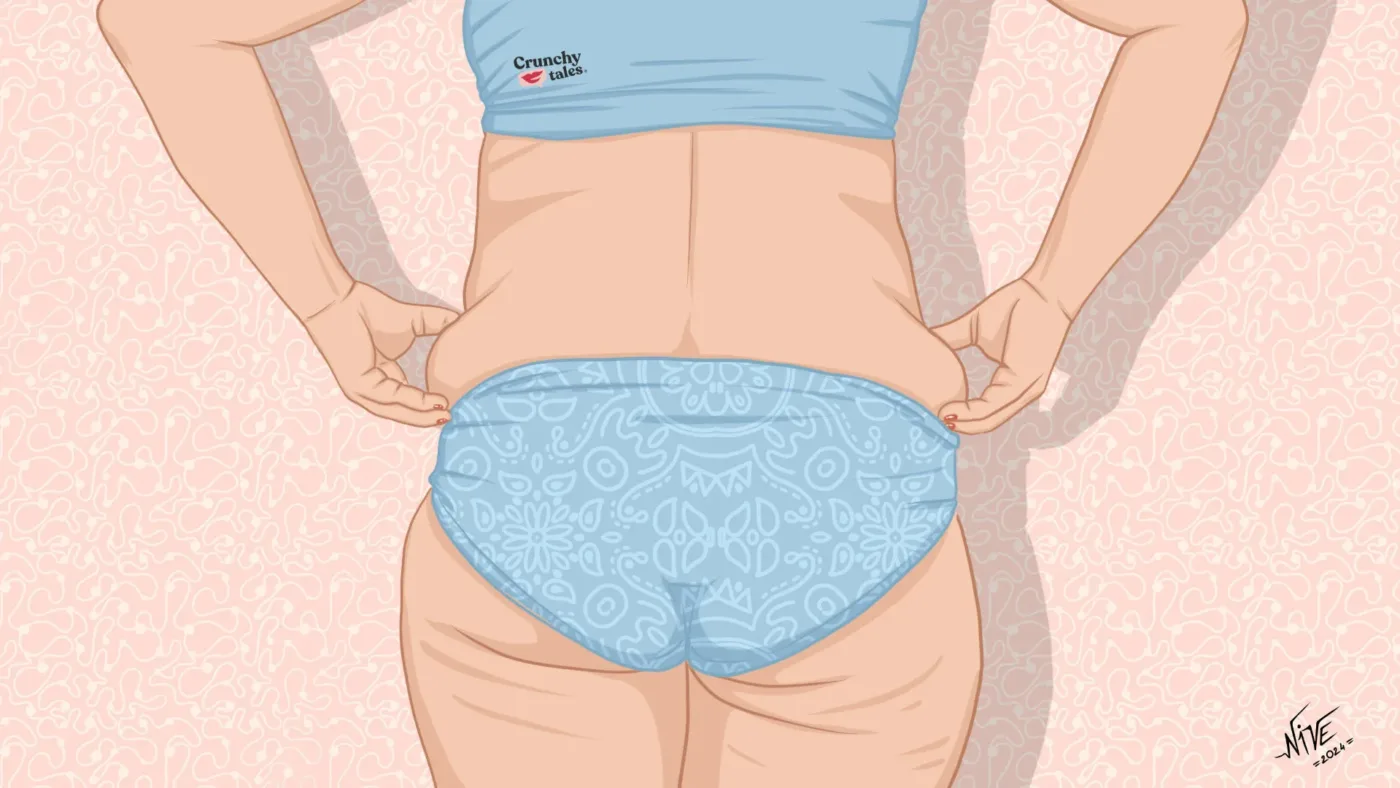The Menopause Effect: Why Cellulite Might Get Worse and What You Can Do About It
Menopause has many symptoms that may force us to put up with several challenges. But amongst hot flashes, mood swings, sleep disturbances, and changes in weight or energy levels, there is often another unwanted guest who no one seems to talk about: Cellulite.
It’s like a pesky neighbour that moves in during your mid-life crisis, setting up camp in the fluffier regions of your body – the bingo wings, the bootylicious behind, and the chunky thighs.
Usually, genetics and the amount of fat in our body can play a major role in determining how much cellulite we have and how visible it is. But, as we age, it may increase. No matter what we try, that stubborn cellulite just keeps making itself known, leaving us feeling defeated.
Should we just throw in the towel and accept that cellulite is here to stay? No way! We’re not giving up this battle anytime soon. With the right combination of exercise, a healthy diet, and skincare treatments, we can work to reduce the appearance of it during and after menopause.
It’s all about consistency and finding what works best for our bodies!
Why does cellulite get worse in menopause?
Cellulite can show up at any point in a woman’s life, but it tends to become more noticeable during menopause. This is mainly due to lower estrogen levels, which can cause blood vessels to become more permeable and lose their tone. This change messes with microcirculation and plays a big role in the formation of cellulite.
With less estrogen, there’s also a drop in the production of elastin and collagen, the proteins that help keep skin tight and smooth. When these levels fall, the connective tissue weakens, and the skin thins out.
No wonder why, cellulite gets worse but fortunately there are some ways to keep it a bay.
Is there a solution for cellulite in menopause?
Cellulite is a common occurrence for many women over 50, but fortunately, there are ways to help reduce the appearance of it during menopause. Here are some tips for you from leading experts in skincare and health.
- Stay Active with Targeted Exercises
For women, the drop in estrogen that comes with menopause makes changes in body composition even worse. Not only do we lose muscle faster post-menopause, but we also tend to gain more fat. The only way to slow the process, minimize cellulite and maintain — or even gain — muscle after menopause is to strength train. Lifting weights builds muscle, increases strength and even helps with balance and agility.
According to UCLA Health, a HIIT workout can be adapted to any fitness level. If you typically walk for exercise, mix in several 30-second spurts of speed walking. If you run, turn those intervals into sprints. It may take a little more work to stay fit after menopause, but with the right types of exercise, you can get stronger at any age.
- Hydrate for Smoother Skin
Water is essential for keeping your skin looking youthful and firm. As dehydration can make cellulite more noticeable by making your skin thinner and less elastic, women in menopause should aim to drink at least 8 glasses of water a day to keep it plump, and smooth (add slices of lemon or cucumber to your water for an extra refreshing boost).
“Skin needs hydration from the inside to function properly. Drinking plenty of water helps keep the skin plump, which can reduce the appearance of cellulite,” advises Dr. Melissa Kanchanapoomi Levin, a New York-based dermatologist and founder of Entière Dermatology.
- Revamp Your Diet
What you eat can play a significant role in how your skin looks. A diet rich in antioxidants, omega-3 fatty acids, and lean proteins can improve skin elasticity and reduce inflammation, which can contribute to cellulite.
“Your diet is one of the most powerful tools in managing cellulite. Antioxidants help fight inflammation, while omega-3s support skin elasticity. Avoiding processed foods and sugar can reduce fluid retention and fat accumulation that make cellulite worse,” says nutritionist and wellness expert Dr. Susan Blum.
Next time, instead of your usual sandwich, have a smoothie packed with spinach, chia seeds, and berries for a cellulite-fighting, nutrient-packed treat. And don’t forget to quit smoking!
- Dry Brushing for Lymphatic Drainage
Dry brushing is a classic yet effective technique that helps stimulate blood flow and promote lymphatic drainage, which can reduce the appearance of cellulite over time. Use a natural bristle brush for 5-10 minutes before your shower, gently massage your skin in circular motions, starting from your feet and moving upward and follow up with a moisturizer for the best results.
“Dry brushing stimulates circulation and helps with lymphatic drainage, which can improve the texture and appearance of skin affected by cellulite,” explains Dr. Neal Schultz, a board-certified dermatologist and founder of DermTV.com.
- Moisturize with Retinol-Based Creams
Retinol creams are widely recommended for their anti-ageing properties, and they can also help reduce the visibility of cellulite by boosting collagen production and thickening the skin. Over time, this can help make cellulite less noticeable.
“Retinol is one of the few ingredients that have been shown to increase collagen production and improve the overall appearance of the skin. This can help reduce the look of cellulite by thickening the skin,” says Dr. Whitney Bowe, a New York-based dermatologist.
Researchers from the American Academy Of Dermatology Association also have found that some lotions containing caffeine may have an effect on cellulite. To maintain the results, however, you’ll have to apply the product every day and you’ll need to apply it for 6 months or possibly longer.
- Massage Therapy for Cellulite Reduction
Regular massage therapy can help improve circulation, reduce fluid retention, and break down fat deposits that contribute to cellulite.
Professional massages, particularly those that target lymphatic drainage, can enhance skin texture and improve elasticity, however, at-home massages using a foam roller or handheld massager can also help improve blood flow and break up fat deposits, making the skin look smoother over time. As long as you are consistent.
- Maintain a healthy Weight
During menopause, hormonal changes can lead to weight gain, which may exacerbate cellulite. Maintaining a healthy weight can reduce the amount of fat pushing against your skin, making cellulite less prominent.
Focus on steady, sustainable weight loss rather than crash dieting, which can worsen the appearance of cellulite. Yo-yo dieting or rapid weight loss can in fact weaken the skin and worsen cellulite.
- Consider Non-Invasive Treatments
If you’re looking for more immediate results, several non-invasive procedures can help reduce cellulite. Treatments such as laser therapy, radiofrequency, carboxytherapy or ultrasound use energy to target and break down fat cells beneath the skin. These procedures are often combined with massage or suction techniques to further smooth the skin.
While these treatments can be effective, they usually require multiple sessions and can be costly. It’s important to consult with a dermatologist to determine which option might be best for your skin type and goals.
“Non-invasive treatments like radiofrequency and laser therapies can help firm the skin and reduce fat, but the results are typically temporary. It’s important to have realistic expectations and maintain a healthy lifestyle alongside these treatments,” says Dr. Amy Wechsler, a dermatologist and psychiatrist.
So, now you know: the next time you catch a glimpse of your cellulite in the mirror, just wink and say, “Hey there, old friend!” After all, life’s too short to stress over a few dimples—embrace them and strut your stuff like the fabulous, confident person you are. Cellulite doesn’t stand a chance against that glow!
Like this post? Support Us or Sign up to our newsletter to get more articles like this delivered straight to your inbox!






This Post Has 0 Comments